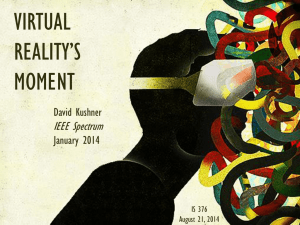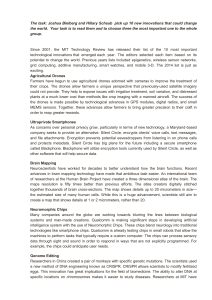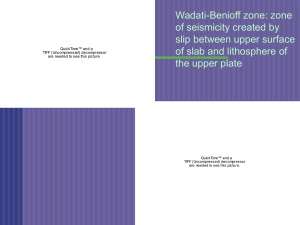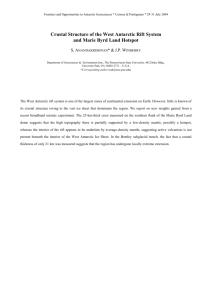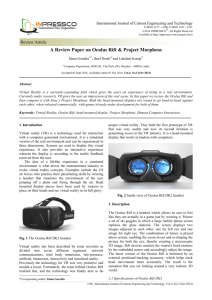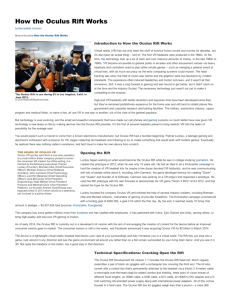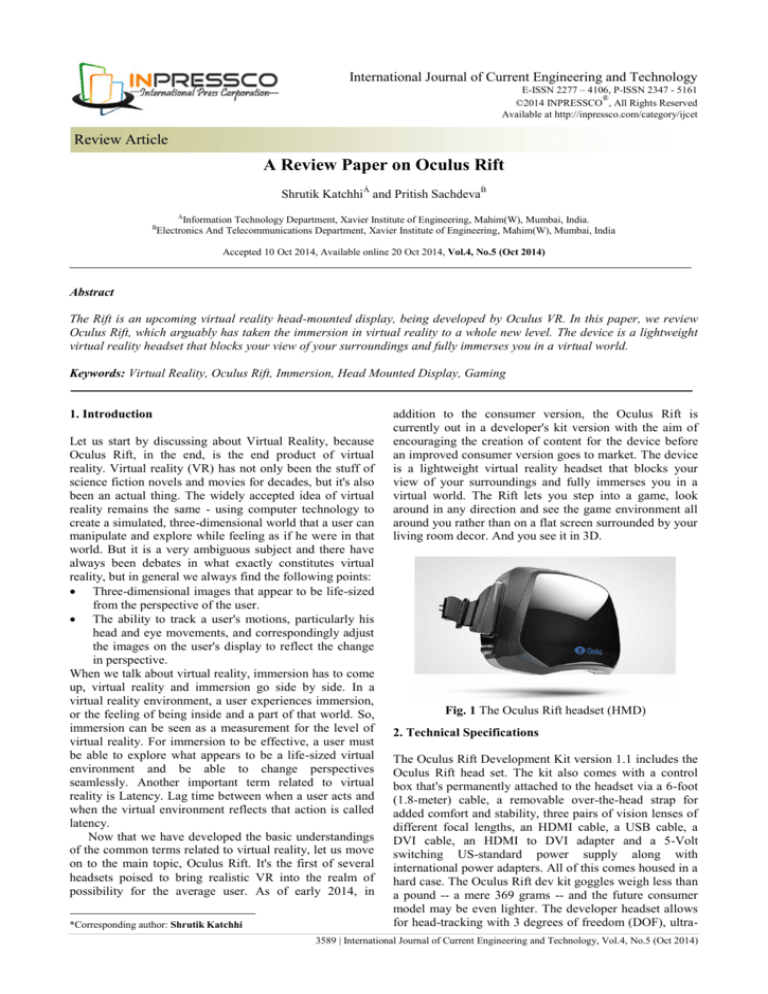
International Journal of Current Engineering and Technology
E-ISSN 2277 – 4106, P-ISSN 2347 - 5161
®
©2014 INPRESSCO , All Rights Reserved
Available at http://inpressco.com/category/ijcet
Review Article
A Review Paper on Oculus Rift
Shrutik KatchhiȦ and Pritish SachdevaḂ
Ȧ
Information Technology Department, Xavier Institute of Engineering, Mahim(W), Mumbai, India.
Electronics And Telecommunications Department, Xavier Institute of Engineering, Mahim(W), Mumbai, India
Ḃ
Accepted 10 Oct 2014, Available online 20 Oct 2014, Vol.4, No.5 (Oct 2014)
Abstract
The Rift is an upcoming virtual reality head-mounted display, being developed by Oculus VR. In this paper, we review
Oculus Rift, which arguably has taken the immersion in virtual reality to a whole new level. The device is a lightweight
virtual reality headset that blocks your view of your surroundings and fully immerses you in a virtual world.
Keywords: Virtual Reality, Oculus Rift, Immersion, Head Mounted Display, Gaming
1. Introduction
1
Let us start by discussing about Virtual Reality, because
Oculus Rift, in the end, is the end product of virtual
reality. Virtual reality (VR) has not only been the stuff of
science fiction novels and movies for decades, but it's also
been an actual thing. The widely accepted idea of virtual
reality remains the same - using computer technology to
create a simulated, three-dimensional world that a user can
manipulate and explore while feeling as if he were in that
world. But it is a very ambiguous subject and there have
always been debates in what exactly constitutes virtual
reality, but in general we always find the following points:
Three-dimensional images that appear to be life-sized
from the perspective of the user.
The ability to track a user's motions, particularly his
head and eye movements, and correspondingly adjust
the images on the user's display to reflect the change
in perspective.
When we talk about virtual reality, immersion has to come
up, virtual reality and immersion go side by side. In a
virtual reality environment, a user experiences immersion,
or the feeling of being inside and a part of that world. So,
immersion can be seen as a measurement for the level of
virtual reality. For immersion to be effective, a user must
be able to explore what appears to be a life-sized virtual
environment and be able to change perspectives
seamlessly. Another important term related to virtual
reality is Latency. Lag time between when a user acts and
when the virtual environment reflects that action is called
latency.
Now that we have developed the basic understandings
of the common terms related to virtual reality, let us move
on to the main topic, Oculus Rift. It's the first of several
headsets poised to bring realistic VR into the realm of
possibility for the average user. As of early 2014, in
*Corresponding author: Shrutik Katchhi
addition to the consumer version, the Oculus Rift is
currently out in a developer's kit version with the aim of
encouraging the creation of content for the device before
an improved consumer version goes to market. The device
is a lightweight virtual reality headset that blocks your
view of your surroundings and fully immerses you in a
virtual world. The Rift lets you step into a game, look
around in any direction and see the game environment all
around you rather than on a flat screen surrounded by your
living room decor. And you see it in 3D.
Fig. 1 The Oculus Rift headset (HMD)
2. Technical Specifications
The Oculus Rift Development Kit version 1.1 includes the
Oculus Rift head set. The kit also comes with a control
box that's permanently attached to the headset via a 6-foot
(1.8-meter) cable, a removable over-the-head strap for
added comfort and stability, three pairs of vision lenses of
different focal lengths, an HDMI cable, a USB cable, a
DVI cable, an HDMI to DVI adapter and a 5-Volt
switching US-standard power supply along with
international power adapters. All of this comes housed in a
hard case. The Oculus Rift dev kit goggles weigh less than
a pound -- a mere 369 grams -- and the future consumer
model may be even lighter. The developer headset allows
for head-tracking with 3 degrees of freedom (DOF), ultra-
3589 | International Journal of Current Engineering and Technology, Vol.4, No.5 (Oct 2014)
Shrutik Katchhi et al
A Review Paper on Oculus Rift
low latency and a field of view (FOV) of 110 degrees
diagonally and 90 degrees horizontally for convincing
immersion. The Rift incorporates a flat 7-inch (17.8centimeter) 60Hz LCD display screen with a resolution of
1280 by 800 pixels (around 720p high-def resolution). The
screen is divided into 640 by 800 pixels per eye, with a
2.5-inch (64-millimeter) fixed distance between lens
centers. The user views the screen through two lens cups.
There are plans to make the consumer model's resolution
at least 1080p, and the company has already demonstrated
two 1080p prototypes (the HD and Crystal Cove models).
The display inputs include DVI-D Single Link, HDMI
1.3+ and USB 2.0 Full Speed+, all fed to it through the
single control box cord.
Fig. 4 Creating VR with a HMD
The Oculus Rift works like a conventional head-mounted
display, but packs a few features that make it ideal for
gaming. For example, the Rift offers impressive headtracking capabilities; stereoscopic 3D rendering; a wide
field of view (110 degrees -- most headsets only offer
around 40 degrees); and several inputs (DVI/HDMI and
USB). When wearing the Oculus, each eye gets close and
personal with a 640x800 LCD screen for a total resolution
of 1,280x800 (720p).
Fig. 2 The Rift without its immersion-producing lenses
Fig. 5 Oculus Rift’s Massive field of view
Fig. 3 The Rift with its immersion-producing lenses
2.1 System Requirements
The Oculus Rift device and Software Development Kit
(SDK) support Linux, Mac OS and Windows operating
systems. There are no specific minimum system
requirements, however some recommended guidelines
include:
Windows (Vista, 7 or 8)
Mac OS 10.6 or higher
Linux (Ubuntu 12.04 LTS)
2.0+ GHz processor
2 GB RAM
Direct3D 10 or OpenGL 3 compatible video card
The Oculus SDK is publicly available and open source,
meaning that anyone can obtain, use and even modify and
distribute the code.
3. Working
For understanding the working of Oculus Rift, we first
need to understand the working of any head mounted
display in VR. The principle in general is called as closed
(video only) HMD. Here, the monitor is mounted very
close to the eye.
4. Adoption
Games and game platforms must be specifically designed
to work correctly with the Oculus Rift. Oculus is
producing a software development kit (SDK) to assist
developers with integrating the Oculus Rift with their
games. The SDK will include code, samples and
documentation. Since its introduction, many developers
have been working on integration. Team Fortress 2 was
the first game to add support for the Oculus Rift, and is
currently available to play with the Oculus Rift
development kit by use of a command line option.
Although at the time of this writing the consumer version
of Oculus Rift isn't out yet, there are already some games
from major developers that have been created or ported to
work with the device. These include:
Doom 3 BFG Edition by id Software - the first
Oculus-ready game.
Eve: Valkyrie by CCP Games - an exclusive launch
title for Oculus Rift.
Team Fortress 2 by Valve - a port that can be played
in VR mode.
Half Life 2 by Valve - another port that can be played
in VR mode.
Hawken by Meteor Entertainment and Adhesive
Games.
3590 | International Journal of Current Engineering and Technology, Vol.4, No.5 (Oct 2014)
Shrutik Katchhi et al
A Review Paper on Oculus Rift
Fig. 6 Team Fortress 2 on Oculus Rift
Unfortunately, not just any 3-D game can be played with
the device just yet. Due to the unique properties of the
Rift, including its wide field of vision and head-tracking
abilities, games and other applications will have to be
specifically made to work with the device.
5. Similar Technologies
5.1 Google glass
Google Glass is a type of wearable technology with an
optical head-mounted display (OHMD). It was developed
by Google with the mission of producing a mass-market
ubiquitous computer.
Project Morpheus is the codename for an upcoming virtual
reality headset produced by Sony Computer
Entertainment. It is designed to be fully functional with
the Sony PlayStation 4 and work with the PlayStation
Vita. It is currently a prototype and will be released
sometime after 2014.
Project Morpheus can truly be considered as a
competition to Oculus Rift. Like Oculus Rift, Project
Morpheus is designed primarily for gaming purposes and
also both the products will be targeted to the same
audience. Neither headset is anywhere near the finished
product though and both companies insist that the design
and technical specifications may change significantly
before release.
5.3 The Sixth Sense Technology
Sixth Sense is a wearable gesture based device that
augments the physical world with digital information and
lets people use natural hand gestures to interact with that
information. It was developed by Pranav Mistry, a PhD
student in the Fluid Interfaces Group at the MIT Media
Lab. A grad student with the Fluid Interfaces Group at
MIT, he caused a storm with his creation of Sixth Sense.
Fig. 7 Google glass
Fig. 9 Sixth Sense Technology
For some reason people always compare Oculus Rift with
Google glass. Apart from the fact that they both are a type
of Head Mounted Display, they are completely different
and they were built for totally different purposes and for
different audience too. Oculus Rift is designed explicitly
for gaming purposes, whereas Google glass is built for a
more general purpose of mobility and connectivity.
Oculus Rift and Sixth Sense are by no means competitors,
in fact, there is a possibility that both technologies can
work in unison and complement each other. The
introduction of the Oculus Rift virtual reality headset is a
particularly exciting development for Sixth Sense because
the headset is a natural match for the 3D input devices.
5.2 Sony’s Project Morpheus
Fig. 8 Project Morpheus
Conclusion
Early impressions of the developer model have been
largely positive. Many people think the Rift is incredibly
cool. On the other hand, there have been the expected
complaints about nausea and dizziness, and some concern
about using glasses with the Oculus Rift. The Rift lets you
step into a game, look around in any direction and see the
game environment all around you rather than on a flat
screen surrounded by your living room decor. And you see
it in 3D. Not quite the technology that we see in fictional
movies yet, but a good step in that direction.
As it always does, technology has improved by leaps
and bounds, graphics have gotten better, and now with the
Oculus Rift, it sounds like more enjoyable and believable
VR is within our grasp.
3591 | International Journal of Current Engineering and Technology, Vol.4, No.5 (Oct 2014)
Shrutik Katchhi et al
A Review Paper on Oculus Rift
References
Antonov, Michael, Nate Mitchell, Andrew Reisse, Lee Cooper,
Steve LaValle, and Max Katsev (2014), Oculus VR - SDK
Overview - SDK Version 0.2.5.
http://static.oculusvr.com/sdk-downloads/
documents
/Oculus_SDK_Overview.pdf
Burke, Steve (2014), The History of Virtual Reality & the
Future:
Rift,
Omni,
Stem,
Castar.
http://www.gamersnexus.net/guides/1208-history-of-virtualreality-and-future
Ceurstemont, Sandrine (2014), Optical illusions help you explore
a virtual world on foot, New Scientist, Volume 218, Issue
2922, Page 22.
Griffin, Ben (2014), The best wearable tech coming in 2014:
Google Glass, Oculus rift, more. Digital Spy.
http://www.digitalspy.com/tech/news/a545509/the-bestwearable-tech-coming-in-2014-google-glass-oculus-riftmore.html
iFixit (2014), Oculus Rift Teardown. http://www.ifixit.com/
Teardown/Oculus+Rift+Teardown/13682
Martin, Tim (2014), The Oculus Rift: virtual reality is no longer
a joke.
http://www.telegraph.co.uk/technology/10540341/The-OculusRift-virtual-reality-is-no-longer-a-joke.html
Ries, Brian (2014) Game On. Newsweek Global. Volume 161,
Issue 16.
3592 | International Journal of Current Engineering and Technology, Vol.4, No.5 (Oct 2014)

